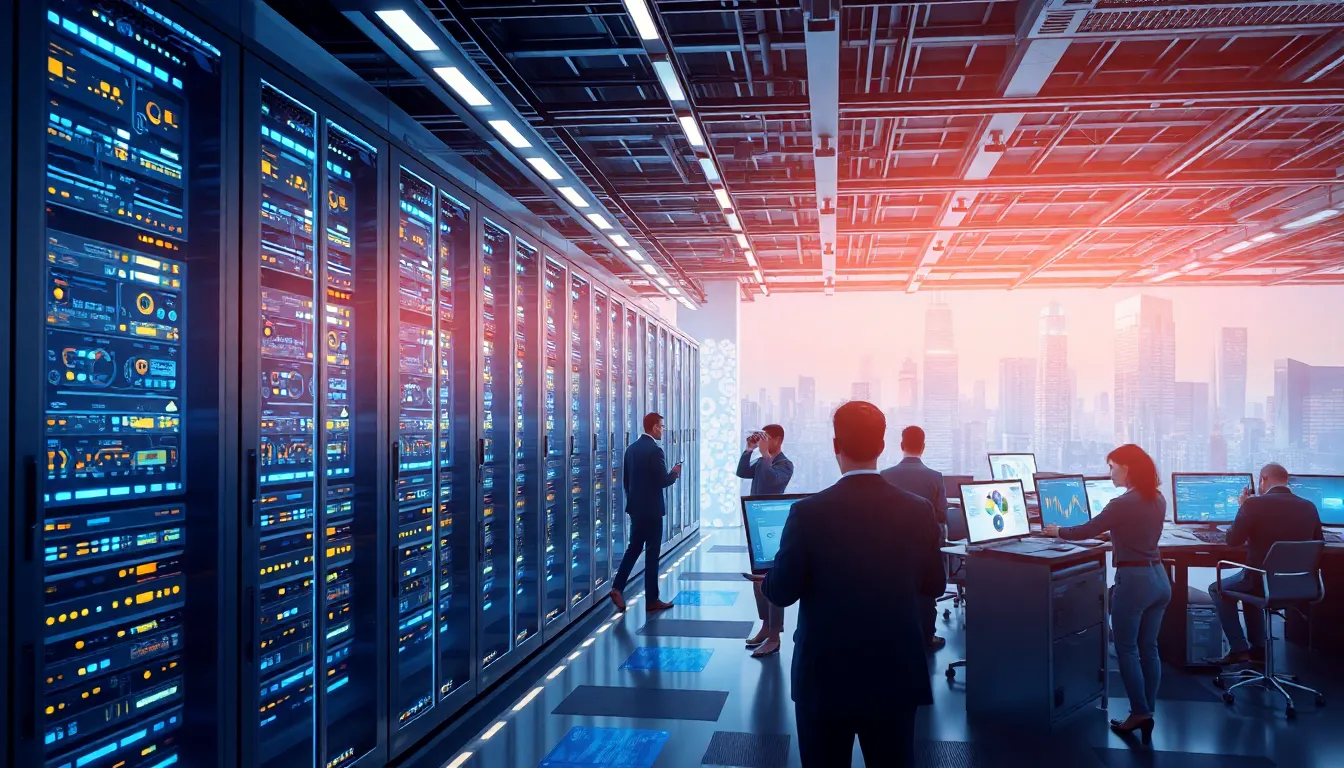Table of Contents
ToggleIn a world where waiting for a webpage to load feels like watching paint dry, edge computing swoops in like a superhero in a spandex suit. It’s all about bringing data processing closer to the action, slashing latency and making sure that your devices don’t have to play a game of telephone with data centers miles away. Imagine your smart fridge not just keeping your groceries cold but also making decisions faster than you can say “what’s for dinner?”
As the Internet of Things expands faster than a cat video on social media, edge computing becomes the unsung hero, ensuring seamless connectivity and real-time responses. It’s not just a tech trend; it’s a game changer that keeps everything running smoothly. Dive into the world of edge computing and discover how it can transform the way we interact with technology—without the lag and with a whole lot more fun.
Overview of Edge Computing
Edge computing involves processing data closer to its source rather than routing it to centralized data centers. This approach significantly reduces latency, which enhances the functionality of internet-connected devices.
Definition and Key Concepts
Edge computing refers to a distributed computing framework. Its goal is to bring computation and data storage closer to the location where it is needed. Devices like smart fridges and IoT sensors leverage this technology to make immediate decisions without excessive delays in data transmission. Key concepts include real-time data processing and localized data management. By utilizing edge devices, organizations can efficiently handle the growing volume of data generated every second.
Importance in Modern Technology
Modern technology relies heavily on edge computing for various applications. It supports real-time analytics, making immediate insights possible for businesses and consumers. Reduced latency plays a crucial role in enhancing user experiences, especially in applications such as autonomous vehicles and smart cities. Organizations can improve operational efficiency by processing data at the edge, resulting in faster response times and lower bandwidth costs. As more devices connect to the internet, edge computing continues to become a vital component of digital infrastructure.
Benefits of Edge Computing

Edge computing offers numerous advantages that enhance the performance and utility of modern technology. By processing data closer to its source, it enables faster and more efficient operations.
Reduced Latency
Decreased latency represents a significant benefit of edge computing. Immediate data processing occurs at the edge, leading to quicker responses. This speed is crucial for applications where split-second decisions matter, such as autonomous vehicles and smart manufacturing. Real-time data analysis minimizes delays caused by long-distance data transmission. Consequently, users experience improved responsiveness and overall satisfaction with connected devices.
Increased Bandwidth Efficiency
Enhanced bandwidth efficiency emerges as another key advantage. By processing data locally, edge computing reduces the volume of data that must travel over networks. This localized data handling alleviates congestion on central servers and improves network performance. Optimizing bandwidth usage benefits both individual users and organizations, as it lowers costs associated with data transfer and storage. Many devices leverage this efficiency for better productivity and effective resource management.
Enhanced Security
Security improvements underscore the importance of edge computing. Sensitive data can be processed and stored locally, thus reducing exposure to potential breaches during transmission. By minimizing data movement, organizations can better protect critical information. Additionally, edge computing enables real-time monitoring, allowing for swift responses to potential threats. Stronger security measures support compliance with regulations and instill trust among users, increasing their confidence in digital systems.
Applications of Edge Computing
Edge computing plays a vital role in various industries and applications. This technology enables faster data processing, improves efficiency, and enhances user experiences across different sectors.
Industrial IoT
Industrial IoT leverages edge computing to optimize operations through real-time data analysis. Sensors deployed in manufacturing settings can process data locally, leading to quicker responses in machinery adjustments. Organizations benefit from reduced downtime, improved resource management, and enhanced equipment monitoring. Predictive maintenance becomes highly effective, as local computations allow for immediate action rather than waiting for centralized data processing. Enhanced automation thrives in environments where speed and accuracy are crucial, ensuring that production remains efficient.
Smart Cities
Smart cities utilize edge computing to create a more connected and responsive urban environment. Traffic management systems rely on local data processing to monitor real-time conditions, adjusting signals instantly to alleviate congestion. Waste management becomes more efficient, with sensors analyzing fill levels in bins and scheduling pickups accordingly. Public safety applications benefit, as edge devices facilitate immediate communication in emergency situations. Improved energy management through local analytics optimizes resource utilization, contributing to smarter and more sustainable city developments.
Autonomous Vehicles
Autonomous vehicles depend heavily on edge computing for safe and efficient navigation. These vehicles process data from various sensors in real-time, ensuring rapid decision-making. Local data management reduces latency, enabling the vehicle to react swiftly to changing road conditions or obstacles. Communication between vehicles and infrastructure occurs instantly, increasing safety and optimizing traffic flow. Robust security features protect sensitive information while maintaining compliance with regulations. Enhanced performance combines advanced technologies to create a reliable and smooth driving experience.
Challenges in Edge Computing
Edge computing faces several challenges that impact its widespread adoption and effectiveness. These obstacles include data privacy concerns, integration with existing systems, and scalability issues.
Data Privacy Concerns
Data privacy remains a significant challenge within edge computing. Localized data processing often involves sensitive information, increasing risks of unauthorized access and breaches. Organizations must implement robust security measures to protect data at the edge. Compliance with regulations such as GDPR requires thorough data governance strategies. When edge devices process personal data, maintaining user trust becomes critical. Companies that prioritize security in their edge implementations can better safeguard consumer information.
Integration with Existing Systems
Integration with existing systems poses another hurdle for edge computing. Organizations rely on legacy systems that may not readily support edge technologies. Adapting these systems often requires substantial investments in time and resources. Compatibility issues can limit the potential benefits of edge computing. Collaborating with technology partners can streamline this integration process. Successful implementations depend on the ability to align new edge initiatives with established frameworks.
Scalability Issues
Scalability issues can hinder the growth of edge computing solutions. As the number of connected devices increases, managing data effectively becomes more complex. Organizations may struggle to deploy sufficient infrastructure to support a growing network of edge devices. Addressing scalability entails not only infrastructure upgrades but also strategic planning. Companies must consider the long-term impact of their edge computing architectures. Planning for future expansion ensures that solutions remain effective as demand evolves.
Future Trends in Edge Computing
Edge computing continues to evolve, with several trends emerging that shape its future impact on technology.
Advancements in AI and Machine Learning
AI and machine learning advancements drive significant improvements in edge computing capabilities. Real-time data processing gains importance as algorithms become more sophisticated, allowing for smarter applications across various industries. Increased efficiency occurs, especially in areas like predictive maintenance for manufacturing and intelligent analytics for retail. Edge devices are now capable of processing complex models locally, reducing reliance on cloud resources. These capabilities ensure faster decision-making and improved responsiveness of systems, proving vital for applications requiring immediate insights.
Role in 5G Networks
5G networks play a crucial role in enhancing edge computing performance. Low latency and high bandwidth of 5G allow edge devices to communicate efficiently, enabling seamless data transfer between devices and edge servers. Enhanced connectivity supports more IoT devices, providing the infrastructure necessary for smart cities and autonomous vehicles. The synergy between 5G and edge computing creates opportunities for innovative applications, such as augmented reality and real-time collaborative tools, which demand quick data processing and low delay times. Organizations leveraging these technologies can achieve significant operational improvements and heightened user experiences.
Predictions for Industry Growth
Industry growth predictions indicate a strong upward trend for edge computing adoption. Analysts forecast the global edge computing market to reach approximately $43.4 billion by 2027, indicating a compound annual growth rate of around 38.4%. Enterprises increasingly adopt edge solutions to enhance operational efficiency and drive digital transformation strategies. As more sectors embrace IoT and AI, the demand for localized data processing will rise. Organizations focusing on the integration of edge solutions will likely lead the market, optimizing their processes and improving scalability as they respond to evolving technological demands.
Edge computing is reshaping the technological landscape by enabling faster data processing and improved user experiences. As devices become more interconnected the demand for real-time analytics and localized data management will only grow. Organizations that embrace this technology can expect enhanced operational efficiency and reduced latency in their applications.
While challenges such as data privacy and system integration exist the benefits of edge computing far outweigh the hurdles. With advancements in AI and the rollout of 5G networks the future looks promising. As industries continue to evolve edge computing will play a pivotal role in driving innovation and transforming how we interact with technology in everyday life.







